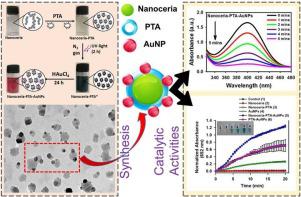Colloids and Surfaces B: Biointerfaces ( IF 5.8 ) Pub Date : 2020-11-20 , DOI: 10.1016/j.colsurfb.2020.111478 Foram Shah 1 , Nisha Yadav 1 , Sanjay Singh 1

|
The catalytic performance of gold (Au) decorated cerium oxide nanoparticles (nanoceria) can be potentially crucial because such a defined arrangement of multiple materials may provide improved chemical and biological catalytic activities. In this work, we have utilized a highly localized approach to reduce Au nanoparticles (AuNPs) on the nanoceria-phosphotungstate composite's surface. Phosphotungstic acid (PTA) bound on nanoceria's surface acts as a UV-light dependent redox molecule that specifically reduces AuNPs. The mechanistic study demonstrates that PTA* molecules' outstanding electron transfer ability leads to an excellent improvement in the catalytic performance of nanoceria-PTA*-AuNPs composite. Nanoceria-PTA*-AuNPs showed better and faster degradation of 4-nitrophenol than either nanoceria or PTA*-AuNPs. The developed nanoceria-PTA*-AuNPs exhibited efficient (>80% in 5 mins) conversion of 4-NP into 4-AP at room temperature and neutral pH. Additionally, the nanoceria-PTA*-AuNPs also showed improved peroxidase enzyme-like activity than the corresponding control samples. The observed catalytic activity could be due to the rapid electron transfer from nanoceria to AuNPs, where the metal nanoparticle acts as an electron sink, mediated by PTA*. Nanoceria-PTA*-AuNPs showed ∼ 2-fold better catalytic oxidation of peroxidase substrate than PTA*-AuNPs. The reported nanoceria-PTA*-AuNPs nanocomposites are expected to display improved biological enzyme-like activities, photocatalysis, and other biomedical applications.
中文翻译:

夹在氧化铈和金纳米颗粒之间的磷钨酸盐表现出增强的4-硝基苯酚催化还原和过氧化物酶样活性
金(Au)装饰的氧化铈纳米颗粒(nanoceria)的催化性能可能至关重要,因为多种材料的这种确定的排列方式可以提供改善的化学和生物催化活性。在这项工作中,我们采用了高度局部化的方法来减少纳米氧化铈-磷钨酸盐复合材料表面上的Au纳米颗粒(AuNPs)。结合在纳米氧化铈表面的磷钨酸(PTA)充当了依赖于紫外线的氧化还原分子,可特异性还原AuNPs。机理研究表明,PTA *分子出色的电子转移能力导致纳米氧化铈-PTA * -AuNPs复合材料的催化性能得到极大改善。纳米氧化铈-PTA * -AuNPs比纳米氧化铈或PTA * -AuNPs显示出更好,更快的4-硝基苯酚降解。在室温和中性pH下,已开发的纳米氧化铈-PTA * -AuNPs可以有效地(5分钟内> 80%)将4-NP转化为4-AP。另外,与相应的对照样品相比,纳米氧化铈-PTA * -AuNPs还显示出改善的过氧化物酶样活性。观察到的催化活性可能是由于电子从纳米氧化铈快速转移到AuNPs,其中金属纳米颗粒充当了由PTA *介导的电子吸收体。纳米氧化铈-PTA * -AuNPs显示过氧化物酶底物的催化氧化性能是PTA * -AuNPs的约2倍。预期已报道的纳米氧化铈-PTA * -AuNPs纳米复合材料将显示出改善的生物酶样活性,光催化和其他生物医学应用。纳米氧化铈-PTA * -AuNPs也显示出比相应的对照样品更好的过氧化物酶样活性。观察到的催化活性可能是由于电子从纳米氧化铈快速转移到AuNPs,其中金属纳米颗粒充当了由PTA *介导的电子吸收体。纳米氧化铈-PTA * -AuNPs显示过氧化物酶底物的催化氧化性能是PTA * -AuNPs的约2倍。预期已报道的纳米氧化铈-PTA * -AuNPs纳米复合材料将显示出改善的生物酶样活性,光催化和其他生物医学应用。纳米氧化铈-PTA * -AuNPs也显示出比相应的对照样品更好的过氧化物酶样活性。观察到的催化活性可能是由于电子从纳米氧化铈快速转移到AuNPs,其中金属纳米颗粒充当了由PTA *介导的电子吸收体。纳米氧化铈-PTA * -AuNPs显示过氧化物酶底物的催化氧化性能是PTA * -AuNPs的约2倍。预期已报道的纳米氧化铈-PTA * -AuNPs纳米复合材料将显示出改善的生物酶样活性,光催化和其他生物医学应用。纳米氧化铈-PTA * -AuNPs显示过氧化物酶底物的催化氧化性能是PTA * -AuNPs的约2倍。预期已报道的纳米氧化铈-PTA * -AuNPs纳米复合材料将显示出改善的生物酶样活性,光催化和其他生物医学应用。纳米氧化铈-PTA * -AuNPs显示过氧化物酶底物的催化氧化性能是PTA * -AuNPs的约2倍。预期已报道的纳米氧化铈-PTA * -AuNPs纳米复合材料将显示出改善的生物酶样活性,光催化和其他生物医学应用。



























 京公网安备 11010802027423号
京公网安备 11010802027423号